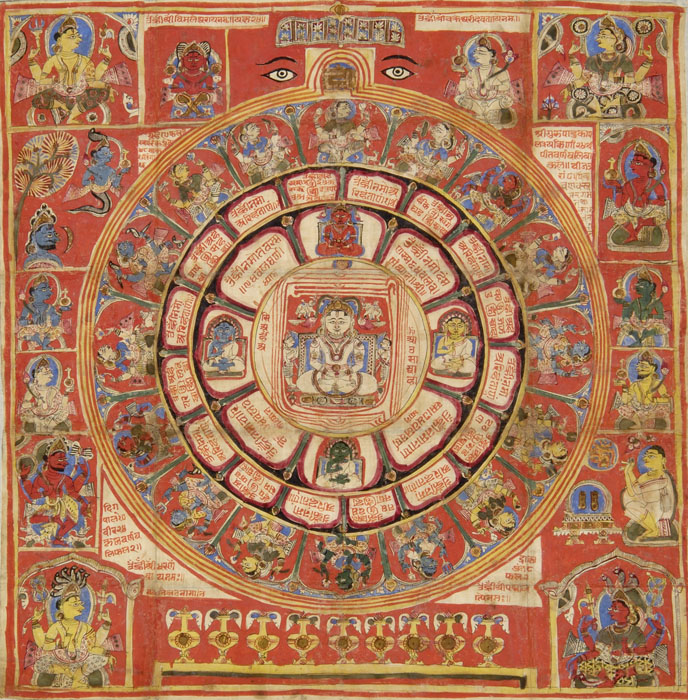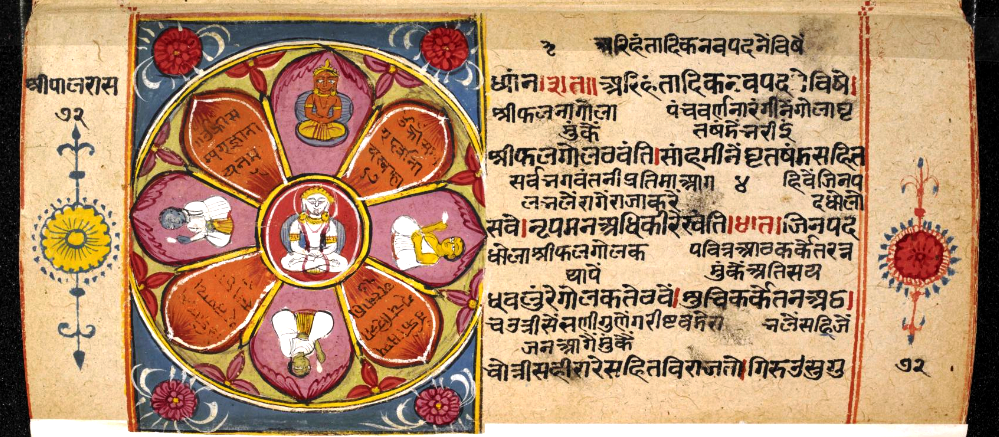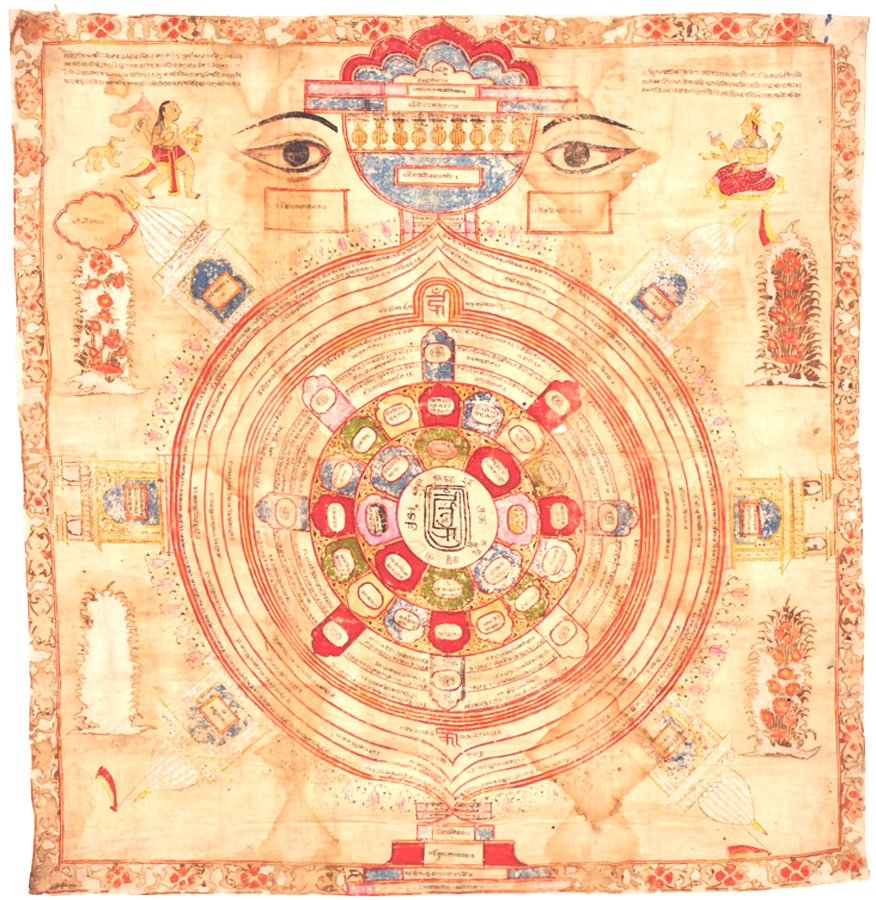Siddhachakra on:
[Wikipedia]
[Google]
[Amazon]
 Siddhachakra is a popular
Siddhachakra is a popular
 The legend takes place during the time of the twentieth Jain
The legend takes place during the time of the twentieth Jain

 There are two types of Siddhachakra. The small types have only a central part depicting ''Nav pada'' which only includes Arihant,
There are two types of Siddhachakra. The small types have only a central part depicting ''Nav pada'' which only includes Arihant,



Siddhachakra in JainpediaStory of Śrīpal and Mayṇasundarī in JainpediaVideo explaining Siddhachakra provided by the Victoria and Albert Museum in LondonManuscript of Śrīpāla-rāsa and Gujarati commentary by Vinayvijaya and Yashovijaya of the 17th or 18th century
{{DEFAULTSORT:Siddha-Chakra Jain symbols
 Siddhachakra is a popular
Siddhachakra is a popular yantra
Yantra () (literally "machine, contraption") is a geometrical diagram, mainly from the Tantric traditions of the Indian religions. Yantras are used for the worship of deities in temples or at home; as an aid in meditation; used for the benefits ...
or mandala
A mandala ( sa, मण्डल, maṇḍala, circle, ) is a geometric configuration of symbols. In various spiritual traditions, mandalas may be employed for focusing attention of practitioners and adepts, as a spiritual guidance tool, for e ...
(mystical diagram) used for worship in Jainism
Jainism ( ), also known as Jain Dharma, is an Indian religions, Indian religion. Jainism traces its spiritual ideas and history through the succession of twenty-four tirthankaras (supreme preachers of ''Dharma''), with the first in the current ...
. It is also known as Navapada in the Svetambara tradition and Navadevta in the Digambara
''Digambara'' (; "sky-clad") is one of the two major schools of Jainism, the other being ''Śvētāmbara'' (white-clad). The Sanskrit word ''Digambara'' means "sky-clad", referring to their traditional monastic practice of neither possessing n ...
tradition. In the Svetambara tradition it is associated with the Namokar Mantra
The Ṇamōkāra mantra or Navkar Mantra is the most significant mantra in Jainism, and one of the oldest mantras in continuous practice. This is the first prayer recited by the Jains while meditating. The mantra is also variously referred to ...
. It is related to the legend of King Shripala and his wife Mayanasundari. It is depicted as a ''Kalasha'' with the core of a blossomed lotus representing Navapada in the centre surrounded by guarding deities on petals. It is used in some rituals.
Etymology
''Siddha'' refers to a liberated soul, while ''chakra'' means wheel. It is believed that worshiping Siddhachakra results in freedom from the cycles of life within a universal 'wheel' known asnirvana
( , , ; sa, निर्वाण} ''nirvāṇa'' ; Pali: ''nibbāna''; Prakrit: ''ṇivvāṇa''; literally, "blown out", as in an oil lampRichard Gombrich, ''Theravada Buddhism: A Social History from Ancient Benāres to Modern Colombo.' ...
. It also means a 'circle of perfection'. ''Navapada'' means 'nine petals' in reference to the centre of the yantra, while ''Navadevta'' means 'nine deities'. It is also described as a 'saint wheel'.
History
The two major sects of Jainism, Svetambara andDigambara
''Digambara'' (; "sky-clad") is one of the two major schools of Jainism, the other being ''Śvētāmbara'' (white-clad). The Sanskrit word ''Digambara'' means "sky-clad", referring to their traditional monastic practice of neither possessing n ...
, differ in their concept of ''Siddhachakra''. The first five deities, known as the ''Panch Parmeshthi
The Panchayat raj is a political system, originating from the Indian subcontinent, found mainly in India, Pakistan, Bangladesh, Sri Lanka, and Nepal. It is the oldest system of local government in the Indian subcontinent, and historical menti ...
'' (five supreme beings) are the same in both traditions while the other four are different. They were traditionally known as Navapada in the Svetambara tradition and Navadevta in the Digambara
''Digambara'' (; "sky-clad") is one of the two major schools of Jainism, the other being ''Śvētāmbara'' (white-clad). The Sanskrit word ''Digambara'' means "sky-clad", referring to their traditional monastic practice of neither possessing n ...
tradition.
Svetambara
''Siddhachakra'' most likely originally had only the ''Panch Parmesthi'', ''Arihant'' in the center and the other four in petals in four different directions. It may have been inspired from ''Namaskara Valaya'' based on theNamokar Mantra
The Ṇamōkāra mantra or Navkar Mantra is the most significant mantra in Jainism, and one of the oldest mantras in continuous practice. This is the first prayer recited by the Jains while meditating. The mantra is also variously referred to ...
as in some older ''Siddhachakra''. The four last lines describing ''phalashruti'' (benefits) are depicted in addition to the petals at the four corners. They are described by Acharya Hemachandra
Hemachandra was a 12th century () Indian Jain saint, scholar, poet, mathematician, philosopher, yogi, grammarian, law theorist, historian, lexicographer, rhetorician, logician, and prosodist. Noted as a prodigy by his contemporaries, he gai ...
in ''Yogashastra''. He also noted that ''Vajraswami'' (BCE 57 – 57 CE) derived it from the lost ''Vidyanupravad parva'' text.
It seems that the other four ''pada''s were added later. Acharya Dinkara (1411 CE) described ''Navapada'' in ''Nandyavrata Mandala''. Nirvanakalika (c. 11th century) described it but replaced ''Tapa'' with ''Suchi-vidya''.
Ratnamandira Gani or Acharya Ratnashekhara wrote about the legend of Shripal in ''Siri-Sirivala-Kaha'' in Prakrit
The Prakrits (; sa, prākṛta; psu, 𑀧𑀸𑀉𑀤, ; pka, ) are a group of vernacular Middle Indo-Aryan languages that were used in the Indian subcontinent from around the 3rd century BCE to the 8th century CE. The term Prakrit is usu ...
along with Siddhachakra Puja in 1372 or 1362 CE, the earliest known reference. A later popular version called ''Shripal Rajano Ras'' was written in 1682 CE by Vinayvijay and Yashovijay.
Legend
 The legend takes place during the time of the twentieth Jain
The legend takes place during the time of the twentieth Jain Tirthankara
In Jainism, a ''Tirthankara'' (Sanskrit: '; English: literally a 'ford-maker') is a saviour and spiritual teacher of the ''dharma'' (righteous path). The word ''tirthankara'' signifies the founder of a '' tirtha'', which is a fordable passag ...
Munisuvrata
Munisuvrata () was the twentieth ''tirthankara'' of the present half time cycle (''avasarpini'') in Jain cosmology. He became a siddha, a liberated soul which has destroyed all of his karma. Events of the Jaina version of Ramayana are placed ...
, about 1.1 million years ago according to Jain traditions. There was a king named Singharth and a queen Kamalprabha of Champanagar. His brother Ajitsen captured Champanagar when he died. To save five-year-old Shripal from his uncle, Kamalprabha fled from the city and left him with a group of lepers while being chased by soldiers. Shripal was also infected by leprosy. He changed his name to Umar Rana and became the group's leader.
Eventually he reached Ujjain
Ujjain (, Hindustani language, Hindustani pronunciation: Help:IPA/Hindi and Urdu, �d͡ːʒɛːn is a city in Ujjain district of the States and territories of India, Indian state of Madhya Pradesh. It is the fifth-largest city in Madhya Prad ...
where King Prajapal was ruling. Out of anger from being disrespected by his daughter, Mayanasundari, he married her to the leprous Shripal. They met a Jain monk, Munichandra, who advised them to do a ritual named Ayambil Oli which is dedicated to the central ''Navpada'' in Siddhachakra. It cured Shripal's leprosy along with that of 700 other lepers. Later he conquered Ujjain and Champanagar.
Digambara
''Navdevata'' was depicted as ''Pratishtha-vidhi-mandala'' in ''Pratishtha-tilaka'' by Nemichandra (c. 15th century). It was also described in ''Pratishtha-Sirodhara'' by Ashadhar, ''Jin-samhita'' by Indranandi (c. 10th century), and ''Paratishtha-Kalpa-Tippanam'' by Kumudchanra. ''Jinasamhita'' by Ekasamdhi (c. 1250 CE) described it in detail, depicting it as similar to ''Brihad Siddhachakra''.Types

 There are two types of Siddhachakra. The small types have only a central part depicting ''Nav pada'' which only includes Arihant,
There are two types of Siddhachakra. The small types have only a central part depicting ''Nav pada'' which only includes Arihant, Siddha
''Siddha'' (Sanskrit: '; "perfected one") is a term that is used widely in Indian religions and culture. It means "one who is accomplished." It refers to perfected masters who have achieved a high degree of physical as well as spiritual ...
(liberated souls), Acharya
In Indian religions and society, an ''acharya'' (Sanskrit: आचार्य, IAST: ; Pali: ''ācariya'') is a preceptor and expert instructor in matters such as religion, or any other subject. An acharya is a highly learned person with a tit ...
(leaders), Upadhyaya
Upadhyaya is a Brahmin name from Sanskrit ''upādhyāya'' "teacher" (from ''upa'' ‘with, under’ + ''adhyāya'' ‘studying’).https://www.ancestry.ca/name-origin?surname=Upadhyay
Notable people
*Amar Upadhyay, Indian model, film and telev ...
(teachers) and Sadhu
''Sadhu'' ( sa, साधु, IAST: ' (male), ''sādhvī'' or ''sādhvīne'' (female)), also spelled ''saddhu'', is a religious ascetic, mendicant or any holy person in Hinduism, Buddhism, and Jainism who has renounced the worldly life. Th ...
(monks) along with the other four. Large types includes all of the structures described below called ''Brihad Siddhachakra'' or ''Siddhachakra Mahayantra''. Small types are found frequently in Jain temples and in carvings while larger ones are found in brass plate form or made of different lentils during rituals on special occasions.
Structure
It is depicted as aKalasha
A kalasha, also spelled kalash or kalasa, also called ghat or ghot ( sa, कलश , Telugu: కలశము Kannada: ಕಳಶ literally "pitcher, pot"), is a metal (brass, copper, silver or gold) pot with a large base and small mouth, large eno ...
with an eye on both sides and a core made of a fully blossomed lotus. It has many circles of petals marking different concepts in Jainism
Jainism ( ), also known as Jain Dharma, is an Indian religions, Indian religion. Jainism traces its spiritual ideas and history through the succession of twenty-four tirthankaras (supreme preachers of ''Dharma''), with the first in the current ...
.


Kalasha
A ''Kalasha'' is depicted as a pot with a large base and a mouth generally covered with a lid or topped with a coronet of mango leaves and a coconut. It is decorated with clothes and ornaments in images. Two eyes are depicted around the Kalasha, symbolising right faith and right knowledge. At the neck of the ''Kalasha'' are nine small pots known as ''NavNidhi
In the context of Hindu scriptures, "Nidhi" is a treasure, constituted of nine treasures (''nawanidhi'') belonging to Kubera (also spelt as Kuvera), the god of wealth. According to the tradition, each nidhi is personified as having a guardian spi ...
'' which describe nine kinds of wealth or treasures.
Nine shrines dedicated to ''Navagraha
Navagraha are nine heavenly bodies and deities that influence human life on Earth according to Hinduism and Hindu astrology. The term is derived from ''nava'' ( sa, नव "nine") and ''graha'' ( sa, ग्रह "planet, seizing, laying hold of, ...
'' are at the base of ''Kalasha'' which indicate nine 'cosmic influencers'.
Lotus
At the core is a fully blossomed lotus with many circles of petals marking different concepts inJainism
Jainism ( ), also known as Jain Dharma, is an Indian religions, Indian religion. Jainism traces its spiritual ideas and history through the succession of twenty-four tirthankaras (supreme preachers of ''Dharma''), with the first in the current ...
. ''Navpada'' (Nine elements) is at the core surrounded by circles of petals called ''valaya''. There is variation in the number of circles made by the petals in different images but generally there are ten circles.
Navapada
Navapada is the core of the lotus. Navapada includes five supreme beings having virtues, ''Guni'' or ''Panch Parmeshthi
The Panchayat raj is a political system, originating from the Indian subcontinent, found mainly in India, Pakistan, Bangladesh, Sri Lanka, and Nepal. It is the oldest system of local government in the Indian subcontinent, and historical menti ...
'', and four ''right'' virtues, ''Guna''s according to Svetambara tradition. Their attributes are described in 108 scriptures. They are also illustrated in silver or copper plates for worship. In the Digambara
''Digambara'' (; "sky-clad") is one of the two major schools of Jainism, the other being ''Śvētāmbara'' (white-clad). The Sanskrit word ''Digambara'' means "sky-clad", referring to their traditional monastic practice of neither possessing n ...
tradition, it has the same ''Panch Parmeshthi'' but the other four elements are different.
Valaya
''Navapada'' is surrounded by circles of petals called ''valaya'' which describe various concepts and guarding deities as mantras. Some have additional petals describing four ''vira'' (guarding deities) and ten ''Digpala'' (protectors of ten directions).Surroundings
The sun and moon are depicted on the right and left side of the ''Kalasha'', respectively. There are four shrines with guarding deities in the four corners:Kshetrapala
Kshetrapala ( Pronounced: Xetra pala) is a guardian deity in Jainism, Buddhism and Hinduism. According to Hinduism and Hindu mythology, Kshetrapala, that is, the lord of the farmland, is a deity who was originally a deity of the farmland, particu ...
, Vimaleshwar, Chakreshvari
In Jain cosmology, Chakeshvari or ''Apraticakra'' is the guardian goddess or Yakshini (attendant deity) of Rishabhanatha. She is the tutelary deity of the Sarawagi Jain community.
Iconography
The color of the goddess is golden. Her Vehicle is ...
, and Aprasiddha Siddha Chakradhisthanak. Sometimes King Shripal and Queen Mayanasundari are depicted on the sides of the ''Kalasha'' as based on a legend.
Rituals

Navapada Aradhana and Ayambil Oli
Navapada Aradhana is associated with the Shripal-Mayanasundari legend. Navapada Aradhana is performed by meditating on ''Navapada'' and doing an ayambil. In an ayambil, only one meal is eaten each day of plain food without any spices, sugar, salt, oil, butter, milk, vegetables or fruits. It is performed for nine days, twice a year. It is called Ayambil Oli. It falls in the months of Chaitra (March/April) and Ashwin (September/October) of theJain calendar
The ''Vira Nirvana Samvat'' (era) is a calendar era beginning on 7 October 527 BCE. It commemorates the Nirvana of Lord Mahaviraswami, the 24th Jain Tirthankara. This is the oldest system of chronological reckoning which is still used in India ...
. A procession of ''Siddhachakra'' is carried out in towns known as ''Jalayatra''.
Siddhachakra Puja
It is a complex ritual taking a half day in which a whole Siddhachakra is created on a floor using lentils. Mantras are recited along with performing ''puja'' starting in the centre of the Siddhachakra and moving towards the outside.See also
*Jain rituals and festivals
Jain rituals play an everyday part in Jainism. Rituals take place daily or more often. Rituals include obligations followed by Jains and various forms of idol worship.
Jains rituals can be separated broadly in two parts: ''Karyn'' (obligations ...
* Jain symbols
Jain symbols are symbols based on the Jain philosophy.
Swastika
The four arms of the swastika symbolize the four states of existence as per Jainism:
a
# Heavenly beings ("''devas encantadia''")
# Human beings
# Hellish beings
# ''Tiryancha'' ...
* Tirthankara
In Jainism, a ''Tirthankara'' (Sanskrit: '; English: literally a 'ford-maker') is a saviour and spiritual teacher of the ''dharma'' (righteous path). The word ''tirthankara'' signifies the founder of a '' tirtha'', which is a fordable passag ...
References
Further reading
*External links
Siddhachakra in Jainpedia
{{DEFAULTSORT:Siddha-Chakra Jain symbols